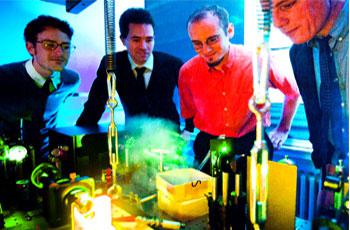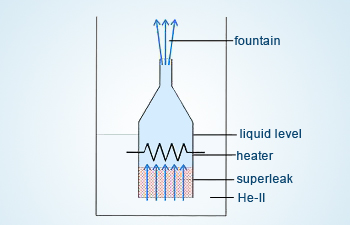 Periodic Table Showing Superconductive Elements
Periodic Table Showing Superconductive Elements
Elements and compounds can be in various forms – solids, liquids or gases are three most common forms. These forms are known as the three common states of matter (phases of matter). There are other states of matter too, like the plasma state and a very recent discovery at ultra low temperatures known as a Bose–Einstein condensate.
Plasma is a mixture of free electrons and ions. Plasma is considered as the fourth state of matter. Plasma occurs naturally in the stars (including the sun). Inside the stars, the temperature is so high that the atoms break up. Some of the electrons break away from the atoms converting the rest of atoms into electrically charged particles called ions. This mixture of free electrons and ions in a star is called plasma. The sun and other stars glow because of the presence of plasma in them.
 BEC (Bose–Einstein condensate)
Bose–Einstein condensate (BEC), a state of matter in which separate atoms or subatomic particles, cooled to near absolute zero (0 K, −273.15°C, or –459.67°F; K = Kelvin), coalesce into a single quantum mechanical entity that is, one that can be described by a wave function on a near–macroscopic scale. This form of matter was predicted in 1924 by Albert.
BEC (Bose–Einstein condensate)
Bose–Einstein condensate (BEC), a state of matter in which separate atoms or subatomic particles, cooled to near absolute zero (0 K, −273.15°C, or –459.67°F; K = Kelvin), coalesce into a single quantum mechanical entity that is, one that can be described by a wave function on a near–macroscopic scale. This form of matter was predicted in 1924 by Albert.
Plasma can also be made on the earth by passing electricity through gases at very low pressures taken in a glass tube (called discharge tube). The fluorescent tubes and neon sign bulbs form plasma when they are switched on. A fluorescent tube may contain helium gas (or some other gas) and a neon sign bulb contains neon gas. When electricity is passed through a fluorescent tube (or neon sign bulb) it glows.
In 1920, an Indian scientist Satyendra Nath Bose did some calculations for the fifth state of matter. On the basis of these calculations, Albert Einstein predicted the existence of a new state of matter called Bose–Einstein Condensate (BEC). The fifth state of matter called Bose–Einstein Condensate was finally achieved by three scientists, Cornell, Ketterle and Wieman of USA by cooling a gas of extremely low density (about one hundred thousandth the density of normal air) to super low temperatures.
 Demonstration of the fountain effect.
A capillary tube is "closed" at one end by a superleak and is placed into a bath of superfluid helium and then heated. The helium flows up through the tube and squirts like a fountain.
Demonstration of the fountain effect.
A capillary tube is "closed" at one end by a superleak and is placed into a bath of superfluid helium and then heated. The helium flows up through the tube and squirts like a fountain.
Super Fluidity:
A superfluid is a special phase of matter in which, when cooled to
temperatures near absolute zero, the molecules exhibit strange quantum effects.
Some superfluids, such as helium–4 (helium with 4 nucleons – 2 protons
& 2 neutrons), are bosons and therefore form a Bose Einstein
Condensate when cooled into liquid form.
One effect of this is that the Viscosity of superfluid
helium–4 becomes zero, meaning that normal rules of Surface
Tension, such as Capillarity are no longer obeyed. A superfluid
in a glass tube will literally "crawl" up the side of the tube
in a thin film because of this property.
Other superfluids, such as helium–3, are fermions, but they
can also exhibit superfluid properties due to other quantum effects
that are part of the BCS theory of superconductivity.
 Helium II will "creep" along surfaces in order to find its own level – after a short while, the levels in the two containers will equalize. The Rollin film also covers the interior of the larger container; if it were not sealed, the helium II would creep out and escape.
Helium II will "creep" along surfaces in order to find its own level – after a short while, the levels in the two containers will equalize. The Rollin film also covers the interior of the larger container; if it were not sealed, the helium II would creep out and escape.
Super Conductivity:
A superconductor is an element or metallic alloy which, when cooled to
near absolute Zero dramatically lose all electrical resistance. In
principle, superconductors can allow electrical current to flow without
any energy loss (although, in practice, an ideal superconductor is very
hard to produce). This type of current is called a Super current.
In addition, superconductors exhibit the Meissner effect in which they
cancel all magnetic flux inside, becoming perfectly diamagnetic
(discovered in 1933). In this case, the magnetic field lines actually
travel around the cooled superconductor. It is this property of
superconductors which is frequently used in magnetic levitation
experiments.
Superconductivity was first discovered in 1911, when mercury was
cooled to 4 degrees Kelvin by Dutch physicist Heike Kamerlingh Onnes,
which earned him the 1913 Nobel Prize in physics. In the years since,
this field has greatly expanded and many other forms of superconductors
have been discovered.
While a photon condensate was considered possible in theory, scientists thought it impossible to actually make one. With decrease in temperature photons are absorbed into matter surrounding them. There are not enough photons left to create a condensate. A team of German scientists solved the problem by bouncing photons between two mirrors positioned extremely close together. A dye between the mirrors absorbed and re–emitted the photons, cooling them to room temperature.
Then the scientists fired a laser into the dye, increasing the number of photons absorbed and reabsorbed in the "photon gas". This produced enough photons to create a room–temperature Bose–Einstein condensate. The most intriguing property of BEC is that they can slow down light. In 1998, Lene Hau of Harvard University and her colleagues slowed light travelling through a BEC from its speed in vacuum of 3 × 108 meters per second to a mere 17 metres per second, or about 38 miles per hour. Since then, Hau and others have completely halted and stored a light pulse within a BEC, later releasing the light unchanged or sending it to a second BEC. These manipulations hold promise for new types of light–based telecommunications, optical storage of data, and quantum computing, though the low–temperature requirements of BEC's offer practical difficulties.